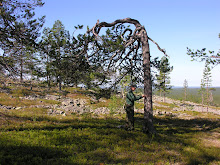How should we estimate
leaf area index for a stand in a boreal forest? How much do the different
LAI estimation methods actually differ? These are questions I’m often asked
when people working in other fields need a quick way to get LAI for their study sites.
In an effort to tackle
these questions, we pooled together our LAI data for nearly 700 stands measured
during the past decade and compared a range of methods such as allometric equations,
LAI-2000 measurements and inversion of a canopy radiation model. Even though we
did not have the so-called true LAI (from destructive sampling) for these
stands, we were still able to get an idea of how the different methods perform.
Many ecosystem or growth models need LAI as an input variable, and therefore it
is crucial to understand how using LAI data from different sources can affect
the modeling results.
Intercalibrating LAI-2000 units in an open area before making measurements in the forest.
Titta measuring the LAI of a Scots pine stand using the LAI-2000 PCA instrument.
Which LAI estimation
method should you use then? There is no simple, straight-forward
recommendation; the optimal LAI estimation method depends on the spatial and
temporal extent of the monitoring activity you will be doing. The optical LAI
estimation methods are usually superior if your research focus is on seasonal
or abrupt changes (e.g. defoliation or insect outbreaks) in foliage mass. In addition,
optical measurements are relatively fast, inexpensive and less laborious than conventional
forest inventories – if you have a camera with a hemispherical lens or an
LAI-2000 Plant Canopy Analyzer at hand and are familiar with the theory behind
them. For large area applications (such as regional or national LAI maps) a
more suitable ground reference method is to use allometric equations based forestry
databases. However, allometric equations cannot (currently) predict the
seasonal development of LAI in a forest. They will only provide you with the
peak growing season LAI which corresponds to the maximum foliage mass in a
forest.
For more quantitative information,
check out Titta’ s new paper:
Majasalmi, T., Rautiainen, M., Stenberg, P. & Lukes, P. 2013. An assessment of ground reference methods for
estimating LAI of boreal forests. Forest Ecology and Management, 292:
10-18.


